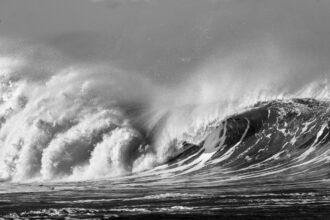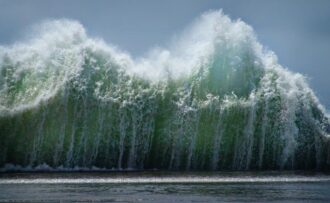Tsunamis can have positive and negative effects. This can be hard to understand as the word tsunami typically means fear. Tsunamis are associated with the downside for several reasons. Some massive tsunami waves can come from oceans without people expecting them and wash away anything they find on land. Despite this, tsunami can have some good results.
History of Tsunamis
Even though most popular tsunamis are from 20th and 21st centuries, some tsunami events can be traced to 4000B.C in China. However, the first recorded tsunamis were in the Mediterranean on the Syrian coast in 2000 B.C. In addition, more than 20 tsunamis were recorded in the B.C era, especially on the Mediterranean coast.
This is mostly because several people have lived in that part of the world since immemorial. In addition, there are few records of other tsunami-affected areas that we know. A good example is Hawaii in the Pacific Ocean. Its tsunami records are new, dating to 1813. Also, tsunami records in Alaska start from 1788, while in the USA, few records exist.
Positive Results of Tsunamis
Tsunamis provide some positive results, as absurd as that may sound. For example, some effects played a significant part in maritime history, such as hazards caused by most world tsunamis, especially in the Pacific Ring of Fire. These positive effects range from connecting distant countries to providing food for big mammals to shorebirds. These advantages include:
Distribution of Organic Matter
One of the actual positive results of tsunamis is the distribution of nutrients. Tsunamis waves can raise organic sediments in deltas and estuaries and move them to land. By doing this, tsunamis can spread nutrients ideal for agriculture, increasing soil fertility.
In addition, when giant waves approach the inland, they spread water inland. In other cases, they can rejuvenate dried-out marine plants like marshes and mangroves. As a result, tsunamis can help restore ruined ecosystems and habitats.
Finally, tsunamis assist in redistributing animal species and nutrients. A great example is how tsunamis increased nutrients in the Bay of Bengal up to three times. At the same time, tsunamis propagate small animals from one area to another.
Create New Habitats
Another positive effect of tsunamis is that they can create new habitats. With nutrient-rich sediments distributed on islands, plants grow fast. As time passes, jungles develop, and animals can find new homes. In addition, it is evident that tsunamis create new habitats and increase the diversity of some species.
A great example is Japan’s tidal marsh sedges, which are almost extinct. However, after the 2011 tsunami, the tidal marshes’ sedges regrew. In addition, the species diversity increased, and researchers argue that the tsunami moved seeds and buried them on the island’s surface.
They Create Landscapes
Another positive impact of tsunamis is that they recreate landscapes. Each time a giant tsunami wave crashes on the shore, it produces a dramatic feature in the beach’s landscape. They can do this by depositing significant amounts of materials on the land. They can also create landscapes by washing away chunks of sand and rocks. As tsunamis deposit these materials on the ground, they generate dump deposits, boulder stacks, ridges, and sand laminae.
At the same time, waves can clear coastal forests and leave potholes or impact marks. This forms ramps, sea caves, truncated cliffs, and arcs.
Economic Opportunities
As more people live in the coastal regions, each time a tsunami occurs, it recalls the need for tsunami-resistant infrastructure and structures. Engineering and architecture firms can provide tsunami resting materials like stilts or other innovative ideas.
Research Opportunities
Tsunami events provide insightful research opportunities to understand the hazard and increase resilience. Thanks to past tsunami events, we now appreciate topics like coastal morphology, island stability, and ecological succession. For instance, low-lying islands are more vulnerable to tsunamis yet more resilient to hazards.
Negative Effects of Tsunamis
The negative effects of tsunamis can be primary or secondary. The primary outcomes are the tsunami results as soon as they hit land and reel back to the ocean. On the other hand, secondary effects occur hours, days, and weeks after the Tsunami event. Here are the disadvantages;
Damage Infrastructure
Since tsunamis clear anything they find on the path, the impact destroys buildings, homes, roads, and communication lines. They ultimately destroy the transport systems of the affected areas.

Social Disruptions and Loss of Lives
Tsunamis occur without warnings. By the time people observe signs of an impending tsunami, it is too late to avoid the effects. Tsunamis cause flooding, which causes death to people by drowning. Waves crash into inlands damaging roads, homes, and buildings, causing death instantly. In 2004, a tsunami in the Indian Ocean killed over 20,000 people in more than 15 countries.
Even though some people survive tsunamis, they can end up with chronic injuries. As buildings and roads collapse, people suffer severe injuries that can prolong lifetime disabilities. In addition, the trauma of the victims can be hard to deal with, especially among children.
Economic Losses
Tsunamis cause massive economic losses. As its giant waves sweep inland, they destroy agricultural, commercial, and residential facilities. Business sectors get affected, including transportation networks and human resources. In addition, tsunamis negatively affect agriculture through soil pollution and harvest destruction. In some cases, they spread diseases amongst livestock.
Damaged Ecosystems
When tsunamis travel from ocean to land, they harm oceanic and terrestrial ecosystems. As they return to the sea, they move and deposit terrestrial sediments on reefs that can turn into polyps and wither. Also, tsunamis can damage ecosystems and throw sediments into rivers and estuaries.
Conclusion
It is no doubt that tsunamis damage the environment. They destroy structures, and vehicles, harm human life and damage coastal systems. They also damage properties, cause loss of lives, and cause soil erosion. They also leave great economic failures, disease outbreaks, and social disruptions, not to mention the trauma to the survivors. Like any other thing, however, they have their advantage even though they outweigh their negative results. They redesign landscapes, increase tsunami research opportunities, redistribute nutrients and create new habitats. Click here, for our guide of the best bitcoin bookies in 2022.


